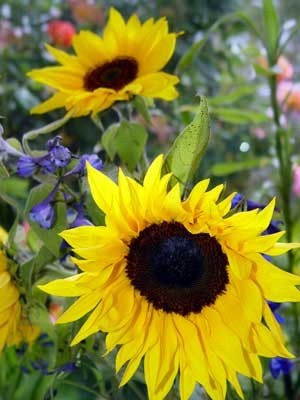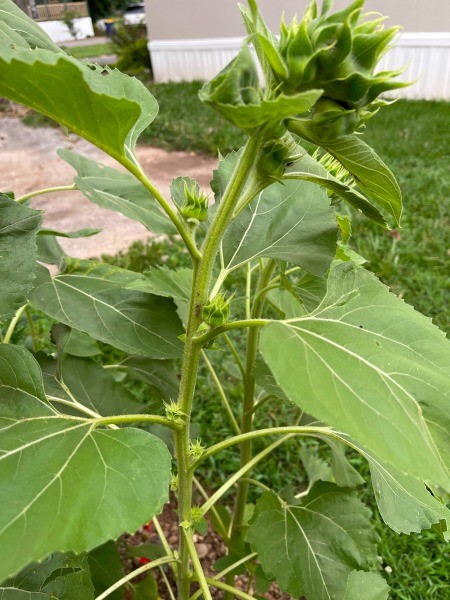 Sunflowers are perhaps the most cheerful and endearing native flower in the United States. For centuries, Native American tribes have harvested these versatile flowers for a variety of nutritional, medicinal and spiritual purposes. Today, they are grown on virtually every continent in the world. Here are some helpful hints for growing and harvesting your own.
Sunflowers are perhaps the most cheerful and endearing native flower in the United States. For centuries, Native American tribes have harvested these versatile flowers for a variety of nutritional, medicinal and spiritual purposes. Today, they are grown on virtually every continent in the world. Here are some helpful hints for growing and harvesting your own.
When purchasing seeds, keep in mind that most commercial varieties of sunflowers seeds are hybrids. This won't make a difference when consuming the seeds, but if your planning on collecting seed for future stock, look for heirloom varieties instead. Seeds should be planted at a depth of 2 inches and spaced 12 inches apart in rows spaced 24 inches apart. Tall varieties or those with extra large heads will need more space. Germination occurs quickly, usually within 7-10 days (often sooner). Most varieties reach maturity in 80-90 days.
The twenty-day period leading up to harvest is the most critical time in the development of sunflower seeds. Avoid placing water stress on plants during this time (either too much or too little) and keep soil moisture levels as consistent as possible.
Non-Insect Pests: Birds and Squirrels love sunflower seeds as much as the gardeners that grow them. Because sunflower seeds mature right around the time these critters are gearing up for fall, your sunflower crop can quickly become ransacked if not protected. Cover sunflower heads with nylon stockings, cheesecloth or paper bags to make robbing the seeds more difficult. Avoid growing your sunflowers near fences or low buildings that offer quick access to squirrels.
Insect Pests: Sunflower moths (the larvae), aphids and white flies are the primary insect pests to watch out for. Sunflowers need bees for pollination, so the use of chemical insecticides isn't recommended. Aphids and white flies can usually be kept under control by periodically spraying your sunflowers with a strong jet of water. Delaying planting until late May or early June will reduce the likelihood of sunflower moth problems.
My sunflowers were about 4-5 feet tall, but not yet flowering. Deer chomped the tops off. Will they continue to grow and eventually flower now?
Put pieces of Irish Spring soap in pantyhose legs and hang them around the sunflowers
When I used to raise sunflowers, I was all about prevention (I liked using old CDs on colorful string to scare off critters). Since they were in the back and side of the house, the esthetics were OK. I polled my friends who still raise them and no one has had luck getting them to re-bloom after deer grazing.
Yes, I've got many of these sunflowers planted in my yard but just this one has blooms growing all the way up the stem. Why is it doing this?
Can you please help me to figure this out? It's driving me crazy not knowing? Please and thank you.
I love sunflowers (in their place) but the branching variety is especially nice as you can many times cut several flowers at one time from only one plant.
There are a large number of different types of sunflowers and quite a few branching types; the branching type is not usually found in stores (maybe could be found in Ace Hardware stores?) and I have always had to order online.
Some sites call these heirloom but many varieties are easy to find online.
Information:
"Branching sunflowers last weeks longer than single cut sunflowers because they keep sprouting new stems, even if they go uncut for a week. They are a true 'cut & come again' cut flower. Branching sunflowers get so tall and literally look like trees with huge branches of sunflowers growing out of their sides (hence the name). I find that branching sunflowers produce stems that are shorter and skinnier, which makes them easier to work with in vase arrangements."
Two of my favorites are; Strawberry Blonde and Maximilian
www.johnnyseeds.com/
www.springhillnursery.com/
Information:
www.johnnyseeds.com/
I feed all birds and they always leave me a gift of Sunflowers. I have hundreds of sunflowers, just from birdseed.
Tips for growing sunflowers from the ThriftyFun community. Plant them in full sun. Plant seeds 1 inch deep and 6 inches apart (or according to package directions). Water well after planting.
I have found feeding your flowers with a nice solution of plant food makes your blooms look wonderful. . .
Here are my giant sunflowers I grew this year. I am only 5'2" so you can see how tall they are. Some of them are 14 feet high. They are beautiful. I have them planted in a square shape around my pumpkin patch.
How do you grow sunflower seeds?
By Kristina K.
You need to buy the seeds (as opposed to trying to plant what you eat). I just dig a small hole drop them in, cover and water. You can also start them inside in a paper cut and transfer outside when ready.
I like to grow the ones that get up to 12 foot (the giant ones) so I plant them along a picket fence around one of my flower gardens so that I can tie them to the fence if needed for support.
They are very fun to grow.
Are sunflowers perennials? Do they re-grow each year or do you have to plant new seeds every year?
Hardiness Zone: 6a
By Mark from Birmingham, MI
While most sunflowers are annuals and the seeds have to be replanted every year, there ARE some very similar to sunflowers that are perennials, depending on the SIZE that you want. Check out by googling or ask etc to ask what is similar to sunflowers but are perennials. I know that helleniums (I am not sure of the spelling), and I think Mullins are similar, if you want tall ones. But if you want true sunflowers, you must plant every year! (But they are sure worth it in beauty!)
Sunflowers are annuals, but do self-seed! Mulliens look like overgrown Foxglove, are annuals too, and also self-seed prolifically. They are not nearly as pretty as sunflowers, and can be quite invasive and do only come in yellow! Helleniums are family members and some are perennials. There are so many beautiful Sunflowers, it is just fun to plant different colors/versions each year. They are varied from creamy whites, to beautiful deep burgundies, even multi-colored!